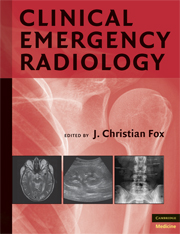Book contents
- Frontmatter
- Contents
- Contributors
- PART I PLAIN RADIOGRAPHY
- PART II ULTRASOUND
- 12 Introduction to Bedside Ultrasound
- 13 Physics of Ultrasound
- 14 Biliary Ultrasound
- 15 Trauma Ultrasound
- 16 Deep Venous Thrombosis
- 17 Cardiac Ultrasound
- 18 Emergency Ultrasonography of the Kidneys and Urinary Tract
- 19 Ultrasonography of the Abdominal Aorta
- 20 Ultrasound-Guided Procedures
- 21 Abdominal—Pelvic Ultrasound
- 22 Ocular Ultrasound
- 23 Testicular Ultrasound
- 24 Abdominal Ultrasound
- 25 Emergency Musculoskeletal Ultrasound
- 26 Soft Tissue Ultrasound
- 27 Ultrasound in Resuscitation
- PART III COMPUTED TOMOGRAPHY
- PART IV MAGNETIC RESONANCE IMAGING
- Index
- Plate Section
15 - Trauma Ultrasound
from PART II - ULTRASOUND
Published online by Cambridge University Press: 07 December 2009
- Frontmatter
- Contents
- Contributors
- PART I PLAIN RADIOGRAPHY
- PART II ULTRASOUND
- 12 Introduction to Bedside Ultrasound
- 13 Physics of Ultrasound
- 14 Biliary Ultrasound
- 15 Trauma Ultrasound
- 16 Deep Venous Thrombosis
- 17 Cardiac Ultrasound
- 18 Emergency Ultrasonography of the Kidneys and Urinary Tract
- 19 Ultrasonography of the Abdominal Aorta
- 20 Ultrasound-Guided Procedures
- 21 Abdominal—Pelvic Ultrasound
- 22 Ocular Ultrasound
- 23 Testicular Ultrasound
- 24 Abdominal Ultrasound
- 25 Emergency Musculoskeletal Ultrasound
- 26 Soft Tissue Ultrasound
- 27 Ultrasound in Resuscitation
- PART III COMPUTED TOMOGRAPHY
- PART IV MAGNETIC RESONANCE IMAGING
- Index
- Plate Section
Summary
INDICATIONS
The use of ultrasound in acute trauma has increased dramatically over the past 30 years. In the 1970s, ultrasound was first used to diagnose hemoperitoneum in the setting of blunt abdominal trauma. Since then, advances in ultrasound technology have led to portable machines that are smaller, easier to use, and boast image quality comparable to their much larger counterparts. Thus, the range of traumatic conditions amenable to assessment with bedside sonography has increased dramatically. Bedside ultrasound is indicated in any patient with penetrating or blunt thoracoabdominal trauma, and may be useful in the assessment of cranial trauma and long bone fractures as well.
The oldest and most established indication for ultrasound in the ED is blunt abdominal trauma. The focused assessment with sonography in trauma (FAST) exam has become a standard imaging modality in the setting of acute trauma and has been incorporated into the American College of Surgeons' Advanced Trauma Life Support guidelines. Ultrasound can be used to assess for free intraperitoneal fluid, and many decision rules support early operative intervention in patients with hemodynamic instability and hemoperitoneum. Hemoperitoneum can also be demonstrated in the setting of penetrating abdominal trauma.
When the FAST exam was first employed, a brief cardiac exam was performed to assess for hemopericardium and tamponade.
- Type
- Chapter
- Information
- Clinical Emergency Radiology , pp. 236 - 245Publisher: Cambridge University PressPrint publication year: 2008

